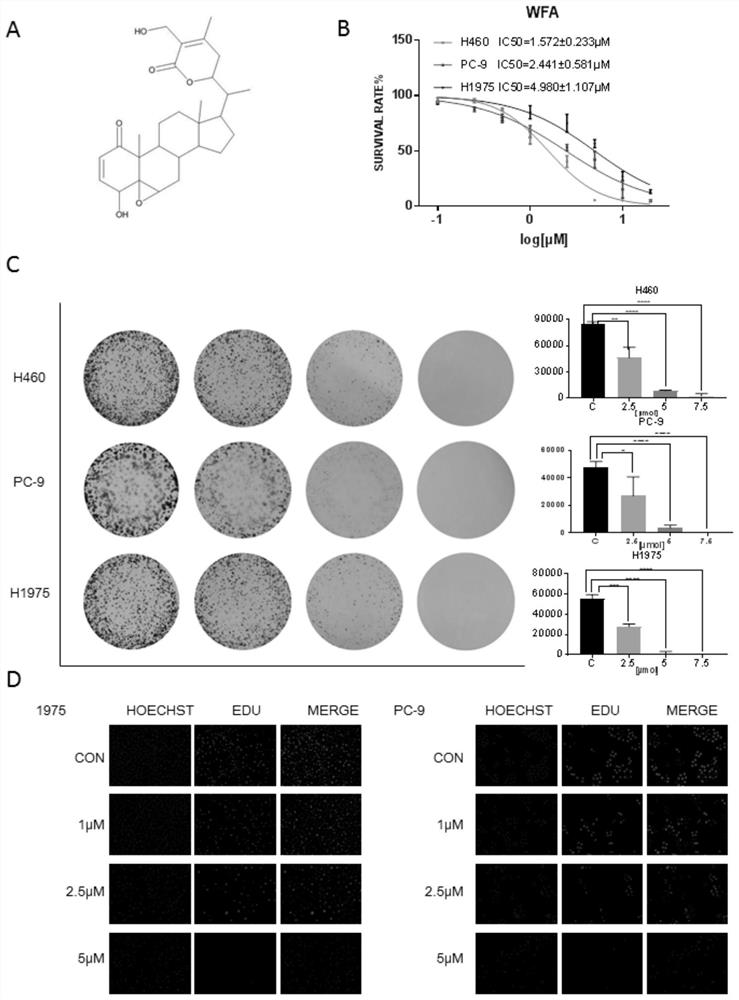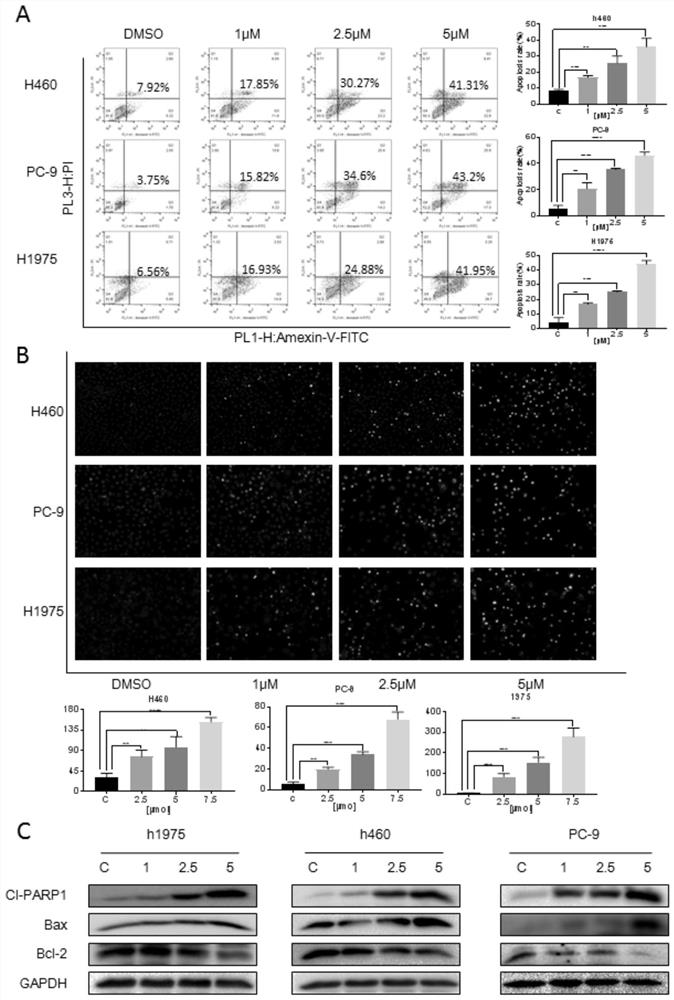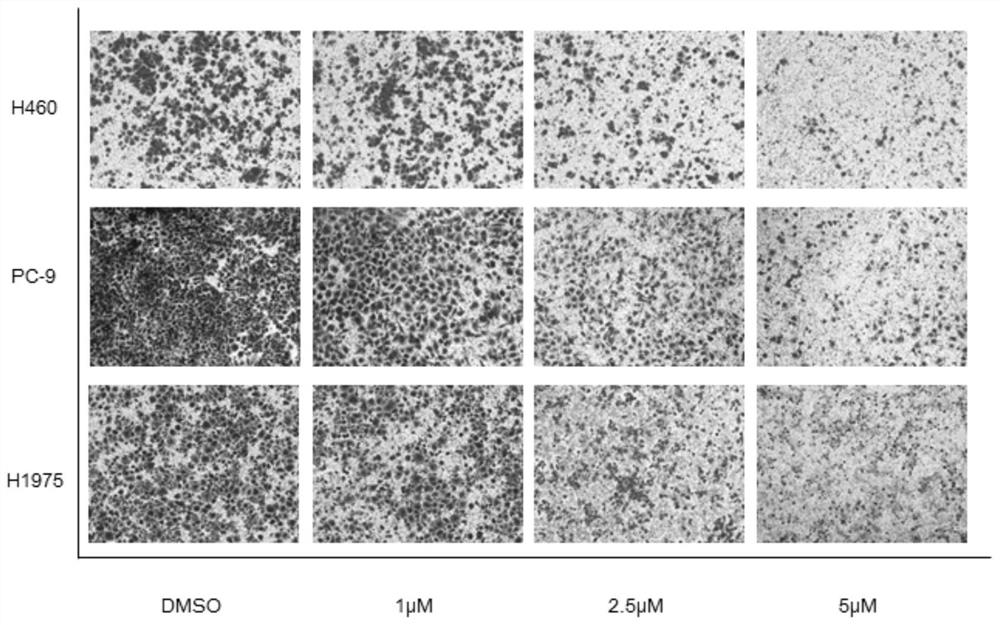Application of withaferin A in preparation of antitumor drugs
An anti-tumor drug, ashwagandha technology, applied in the field of biomedicine, can solve the problem of not significantly improving the survival rate of lung cancer, and achieve the effect of inhibiting the migration ability of NSCLC cells, promoting the apoptosis of NSCLC cells, and strong synergistic effect
- Summary
- Abstract
- Description
- Claims
- Application Information
AI Technical Summary
Problems solved by technology
Method used
Image
Examples
Embodiment 1
[0023] In this example, the anti-proliferation effect of WA on three types of lung cancer cells (H460, H1975 and PC-9) was detected by MTT assay. The specific process is as follows:
[0024] Spread tumor cells in a 96-well plate at a density of 3000-5000 / well, and place them in a constant temperature incubator at 37°C overnight to allow them to adhere to the wall. The next day, 100 μL of fresh complete medium was replaced, and 1 μL / well of corresponding drug concentration (0.1-20 μM) was added. After 48 hours, 25 μL / well of MTT working solution (5 mg / ml) was added in a dark environment. Discard the supernatant after 3-4 hours, add 150 μL / well of DMSO, shake for 5 minutes to fully dissolve, place in a microplate reader, select the detection wavelength at 490 nm, and measure the absorbance (OD) of each well. The result is as figure 1 As shown in B, the half maximal inhibitory concentrations (Half maximalinhibitory concentration, IC50) of WA in H460, H1975 and PC-9 cells were ...
Embodiment 2
[0028] This example explores the effect of WA on the apoptosis of NSCLC cell lines. After the cells were treated with gradient concentrations of WA, the cells were double-labeled with Annexin V-FITC and PI. The results showed that WA treatment could promote the apoptosis of H460, PC-9 and H1975 cells ( figure 2 A). Using Hoechest combined with live cell DNA to distinguish normal cells from mid-to-early apoptotic cells, the results showed that the proportion of mid-to-early apoptotic cells increased after WA treatment. Further detection of apoptotic proteins suggested that WA treatment could induce the expression of apoptotic proteins Cl-PARP and Bax, while inhibiting the expression of anti-apoptotic protein Bcl-2. These results suggest that WA can promote apoptosis in NSCLC cells.
Embodiment 3
[0030] Transwell migration assay was used to detect the effect of WA on cell crawling ability. Add 500 μL / well basal medium to a 24-well plate and put it into a small chamber with a polycarbonate filter membrane. After the cells were digested and centrifuged, the supernatant was discarded, and the cells were resuspended with serum-free basal medium, counted and diluted, and added to the chamber, about 8000 cells / well. After 24 hours, add 500 μL / well fresh complete medium to a new 24-well plate, transfer the small chamber to a new plate, replace 100 μL serum-free basal medium in the small chamber, and then add 1 μL / well of the corresponding concentration of the drug ( 0, 0.25, 0.5, 0.75mM). After 12-24 hours, fix with 4% paraformaldehyde for 15 minutes, and stain with 1% crystal violet for 15 minutes. Gently wipe off the non-migrated cells inside the chamber with a cotton swab, observe and count the number of migrated cells under an optical microscope. The results showed tha...
PUM
 Login to View More
Login to View More Abstract
Description
Claims
Application Information
 Login to View More
Login to View More - R&D Engineer
- R&D Manager
- IP Professional
- Industry Leading Data Capabilities
- Powerful AI technology
- Patent DNA Extraction
Browse by: Latest US Patents, China's latest patents, Technical Efficacy Thesaurus, Application Domain, Technology Topic, Popular Technical Reports.
© 2024 PatSnap. All rights reserved.Legal|Privacy policy|Modern Slavery Act Transparency Statement|Sitemap|About US| Contact US: help@patsnap.com










